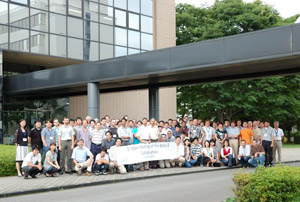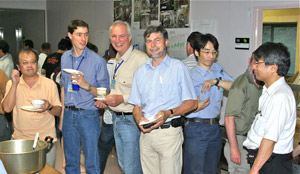| |
 |
Feature Story |
|
 |
Belle II collaboration meets at KEK:
Old and new members meet to discuss the detector technologies
|
On July 7-9, KEK hosted the third Belle II collaboration meeting in Tsukuba, Japan. Attended by around 100 collaborators, this open meeting marked the first conference since May, when the name 'Belle II' was coined. Both long-time SuperKEKB-Belle II collaborators and new, interested particle physicists were present to discuss technologies broadly related to the Belle II detector design.
The SuperKEKB-Belle II experiment is a proposed upgrade of the currently running KEK B-Factory experiment, the pivotal experiment at KEK. The KEK B-Factory experiment has made great progress in exploring the mysteries of matter-antimatter asymmetry by colliding beams of high-energy electrons and positrons. About 100 accelerator experts and dozens of support staffs operate KEKB, while Belle attracts around 400 physicists from 60 institutes in 15 countries.
|
|

The participants of Belle II collaboration meeting at KEK gather around in front of 'San-Go Kan' for a group photo.
|
The KEK B-Factory experiment employs a powerful double-ring collider, KEKB, which has produced about 800 million pairs of B anti-B mesons since beginning operation in 1999. The electron and positron beams accelerated to near the speed of light in the KEKB's 3-kilometer rings collide at the center of the Belle detector, and produce pairs of B and anti-B mesons. These mesons and anti-mesons decay, but B mesons do not have the same decay pattern as anti-B mesons. This, called charge-parity (CP) violation, had long been sought before KEK B-Factory's most notable discovery to date; the experimental confirmation that the Kobayashi-Maskawa's CP violation theory is indeed real in B and K mesons.
To produce particles more effectively, KEKB has been boosting its 'luminosity' record ever higher. Luminosity, the rate of collisions, is a measure to characterize an accelerator's performance. The team achieved the luminosity of 2.11 x 1034 cm-2 s-1 on June 17 this year, renewing own world record. Now KEKB is turned off for the summer when the electricity demand is high in Japan. It will start again this fall before the SuperKEKB-Belle II collaboration hopefully launch into the construction starting next year. The proposed upgrade will require a shutdown of three full years.
"As physicists, many of us are fascinated by the new physics the flavor changing neutral currents, or FCNC, experiment might produce," says Dr. Yutaka Ushiroda at KEK, the technical coordinator for the Belle II collaboration, "and for this, the upgrade is very much looked forward to."
The SuperKEKB-Belle II experiment is expected to produce significant physics even as the world focuses its attention on the Large Hadron Collider (LHC) at CERN. The experiment will study B meson decay in a very clean electron-positron environment at very high luminosity. It will explore the deviations from the Standard Model in flavor physics, and help to distinguish between different models of new physics. For this, physicists are looking for a mechanism to suppress FCNC at TeV energy scale, which often results in a distinctive flavor structure at low energy. The LHC, which is a proton collider operating at very high energy, cannot do this.
The goal of SuperKEKB is to increase the KEKB's luminosity to 8 x 1035 cm-2 s-1. This is about 40 times higher than the current luminosity. Engineering such an increase is a difficult task. To maintain the detector performance under the much harsher beam background produced by the high intensity beams, the physicists are working hard to come up with an optimal design for the next generation Belle detector, Belle II.
"Naturally the detectors closer to the interaction point will undergo much greater design changes," explains Professor Yoshihide Sakai, the Belle's co-spokesperson based at KEK. The most important new component of the Belle II is the innermost detector, pixelated detectors (PXD), inside the silicon vertex detector (SVD), arranged so as to improve the detector's vertex resolution. "The new collaborators from Germany and the Czech Republic made the technology feasible," says Ushiroda.
The meeting offered parallel sessions on each detector component. Discussed components include: PXD, SVD, central drift chamber (CDC), particle identification device (PID), electromagnetic calorimeter (ECL), and KL and muon detector (KLM) in the baseline design; computer and software; the interaction region (IR); data acquisition system (DAQ); and trigger (TRG). The collaboration meet three times a year to share the individual technical designs, as well as to initiate collaborations with accelerator scientists on the interaction region.
The meeting also addressed the massive design change of the interaction region where the accelerator and the detector meet. The accelerator team changed their technical approach drastically in March from the high current approach to a low emittance approach, which was inspired by the proposed Super-B Factory experiment in Italy. The meeting presented the first opportunity for Belle II collaborators to discuss the changes this will bring about.
 The participants line up for food during the party held on July 8 in KEKB Control Building. There were many participants from new member institutions.
The participants line up for food during the party held on July 8 in KEKB Control Building. There were many participants from new member institutions.
|
|
"I am satisfied with how vibrant the meeting went from start to finish," says Ushiroda, "and that's to say how exciting it is to bring up a new collaboration." He also notes that he was happy to see there were many participants from new member institutions. The collaboration is also becoming increasingly international. Currently the Belle II is a collaboration of around 300 physicists from 13 countries/regions: Australia, Austria, China, Japan, Poland, Russia, Slovenia, Taiwan, and 5 new members including the Czech Republic, Germany, India, Korea, and the US.
The next meeting will be held in November. Ushiroda says that by then all the characterization studies must be completed for the sub-detector groups that have not selected their technologies. It may be necessary to launch an internal review committee in August to be sure that all the technologies are finalized in December. The meeting will welcome all particle scientists who are interested in joining the collaboration.
|
|
|



